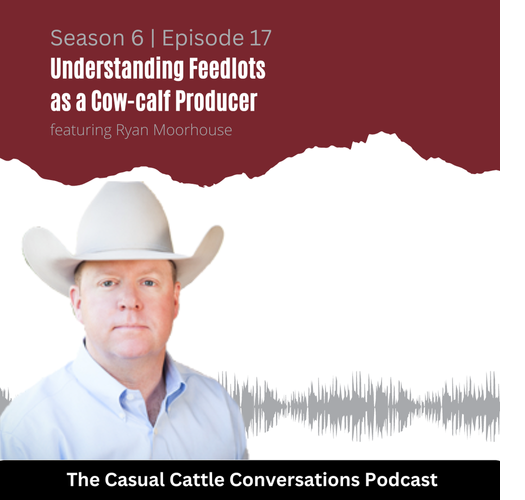The Casual Cattle Conversations Podcast: Understanding Feedlots as a Cow-Calf Producer
Thursday, April 27, 2023
Reference: Podcast Corner

Understanding Feedlots as a Cow-Calf Producer
April 24 | Written By Shaye Koester
You spend a lifetime improving the genetics and overall performance of your herd. You pour your heart and soul into every calf crop too. From making breeding decisions to loading them on the truck, you are watch them grow and keep them healthy. Then what? Where do they go? How do they continue to perform? Are they going to be profitable for you? Ryan Moorhouse, general manager at Hartley Feeders, joins Shaye Koester for a conversation about what cattle producers need to keep in mind to raise calves feedlots want and help them understand the feedlot business.
Click Here to listen to Shaye's Podcast
Moorhouse grew up on a cow-calf and stocker operation, so he has loaded many groups of cattle throughout his career. Growing up on this type of operation made Moorhouse curious about where cattle went and what happened to them after they got loaded on the trailer. This curiosity in combination with the fast pace of the feedlot business is what has kept Moorhouse involved in the feedlot sector for the last 25 years. Moorhouse appreciates his background in the cow-calf sector as it helps him understand the beef business as a whole whether it is buying cattle from ranchers, selling feeders or buying commodities. All sectors of the industry are trying to make profits and it helps build relationships between sectors if you understand their business and yours.
Moorhouse has the opportunity to buy directly from cattle producers. He estimates around 15% of the cattle that come into the facility or direct purchases that did not involve a middleman. Moorhouse recognizes that how cattlemen decide to sell their calves is entirely up to them. “I think there is a need for both options. In some instances, it works better for producers to sell directly to feedyards. However, some people like to have a middleman. I understand both sides of it and we do both sides of it.”, said Moorhouse.
When it comes to building relationships with feedyards, it is important to understand what they are looking for in cattle. If you are selling cattle directly to feedlots, backgrounding and vaccinating them before shipping is preferred. This reduces stress on the calves and sets everyone up for better success. Pen size is another factor that needs to be remembered when building a relationship with feedyards. Pen size is dependent on the yard, but as an example, Moorhouse said the smallest pen he has fits 60 head but he also works with producers who sell 1,000s of head.
It is also important to understand what type of cattle you have. Sure, you see how your cows perform year in and year out and you see their calves grow until you sell them. But, how do you know how they perform in the feedlot and what type of eating experience they give the consumer? “I encourage people to retain ownership in their calves every few years to help them understand what type of cattle they are raising and get closer to their own goals. As a feedyard, we can get you performance and carcass data on your calves. Having this data helps both of us learn in the long run.” said Moorhouse.
Feedlots are businesses that face their own sets of challenges too. Moorhouse says the labor challenge has always been around for them but recently they have been facing short supplies in combination with high feed prices. “We’ve been able to keep yards relatively full for the past 5-7 years and that’s been good. However, I have to remind people that we are margin operators who have to be able to buy and resell the same cattle for a profit. There are many years where cattle feeding has not been profitable. It ebbs and flows.” said Moorhouse.
As Moorhouse looks forward to the future he is excited about educating others about the feedlot business and building more relationships with people in the beef industry. There’s a growing industry in the direct-to-consumer and grass-finished beef spaces but we still need to produce reasonably priced beef for consumers who don’t buy directly from ranchers. Moorhouse sees an increase in popularity for branded beef programs in the future because of this and thinks these programs will continue to be an opportunity for beef cattlemen to add more value to the calves they sell. “You can start at a basic level of verifying you have a good vaccination program and work up to a natural program or GAP 4 certification if you want to. But, we still need regular commodity cattle. There’s a spot for everything.”, said Moorhouse.
To wrap all this up, it all comes down to where you want your operation to go and what you are capable of. There is a place for all kinds of cattle in feedlots across the country. If you want to build a relationship with a feedyard, talk to your middleman to learn where your cattle are going and work with that feedlot to learn how your calves perform.
Sign up to stay connected
- News
- Property Alerts
- Save your favourite properties
- And more!
Joining Farm Marketer is free, easy and you can opt out at any time.

